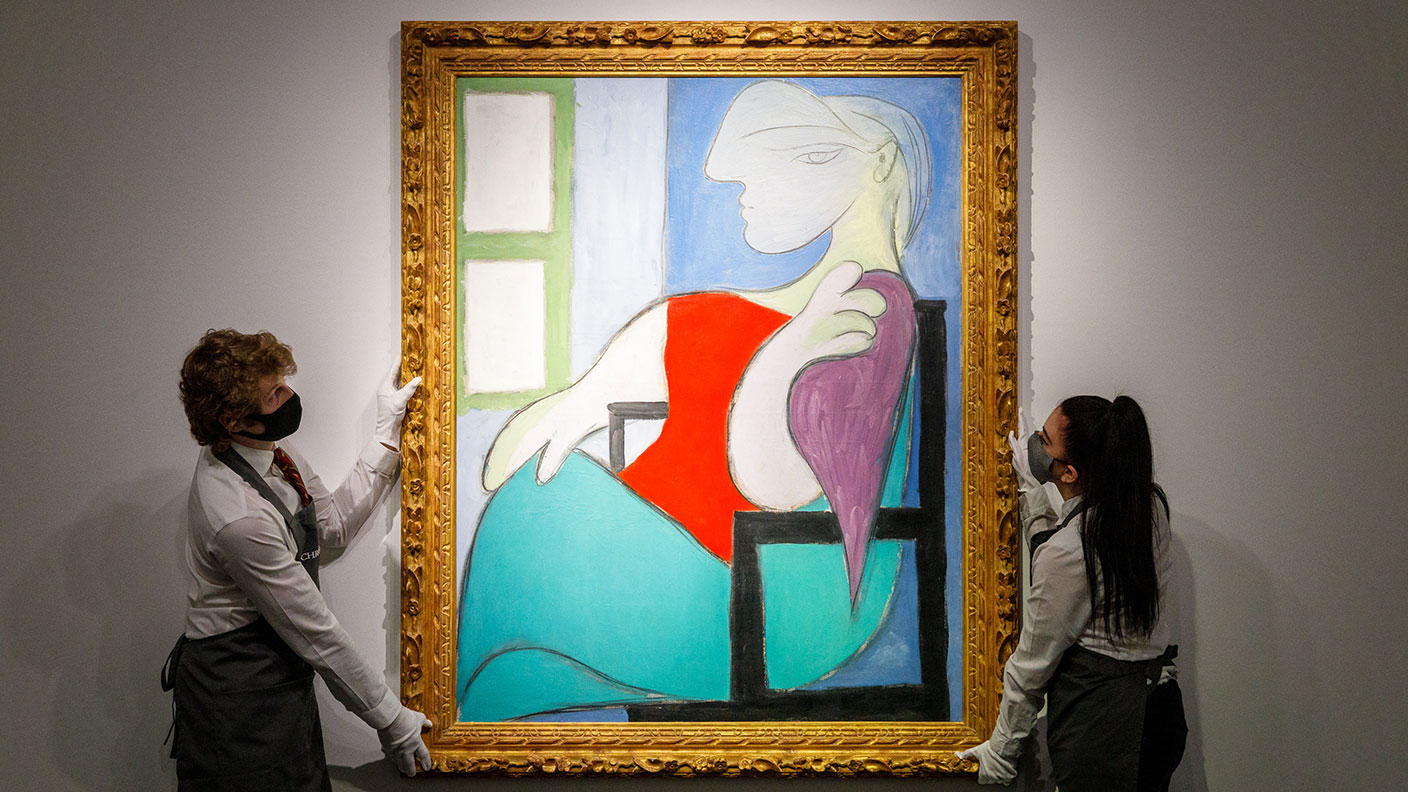The priciest artworks of 2021
The temperature in the art market keeps soaring. Chris Carter reports on 2021's biggest art deals.


1. $103.4m – Femme Assise près d’une Fenêtre (Marie-Thérèse) (1932). Pablo Picasso’s portrait (pictured) of his muse “as a winged goddess, a modern-day Nike”, was the only artwork to sell for nine figures in dollar terms last year, according to Christie’s in New York. That was an improvement on 2020, when none breached the $100m mark.
2. $93.1m – In This Case (1983). Jean-Michel Basquiat underscored his status as the artist of the moment with the sale of this, the last of his three iconic Skull paintings with Christie’s. It was only the second of the three to come to auction, but it didn’t quite reach the $110.5m that Japanese billionaire Yusaku Maezawa paid for Untitled (1982) in 2017.
3. $92.2m – Portrait of a Young Man Holding a Roundel (c.1480). Sandro Botticelli’s painting caused a stir at the start of the year when it was auctioned by Sotheby’s. The price was nine times higher than the previous record for a Botticelli of $10.4m, set in 2013, and the second-highest for an Old Master after Leonardo da Vinci’s Salvator Mundi, which sold for $450m in 2017.
MoneyWeek
Subscribe to MoneyWeek today and get your first six magazine issues absolutely FREE

Sign up to Money Morning
Don't miss the latest investment and personal finances news, market analysis, plus money-saving tips with our free twice-daily newsletter
Don't miss the latest investment and personal finances news, market analysis, plus money-saving tips with our free twice-daily newsletter
4. $82.5m – No.7 (1951). Mark Rothko’s vibrant painting of three luminous and distinct bands of pink, yellow and orange dates from the moment Rothko developed his signature style of abstraction. It was the highest-selling lot from the Macklowe Collection at Sotheby’s $676m sale, which produced four of the top ten highest auction prices, including…
5. $78.4m – Le Nez (1947). Swiss artist Alberto Giacometti was one of the most important sculptors of the 20th century, and his “craggy, emaciated figures… have come to symbolise the human condition in the wake of World War II”, notes Sotheby’s in its catalogue. Le Nez was the only sculpture to make the top-ten list, bought by crypto entrepreneur Justin Sun.
6. $71.4m – Cabanes de Bois Parmi les Oliviers et Cyprès (1889). This Provençal scene of a wooden cabin amid olive trees and cypresses in southern France by Vincent van Gogh was the highlight of Christie’s The Cox Collection: The Story of Impressionism sale in November, which also featured works by Claude Monet, Paul Cézanne and Edgar Degas.
7. $70.4m – Le Bassin aux Nymphéas (1917-1919). Claude Monet’s impressionist work of his iconic water lilies was painted towards the end of his career. It was easily the highest-selling artwork from the Sotheby’s evening sale in May, even if it didn’t reach the $110.7m that Monet’s Meules (1890) fetched in 2019, also with Sotheby’s. But it was higher than…
8. $69.3m – Everydays: The First 5000 Days (2021). While the price for a newly “minted” digital artwork (NFT – non-fungible token) still has some way to go before topping Monet’s century-old paintings, or indeed Botticelli’s 500-plus-year-old work, the astonishing sum achieved for the work by Beeple (Mike Winkelmann) at Christie’s set off the year-defining NFT craze.
9. $61.2m – Number 17 (1951). The final two in the list also came from the Macklowe Collection. Sotheby’s achieved a new high auction price for the artist, American painter Jackson Pollock, when it sold the abstract expressionist work for around twice its pre-sale estimate. Then again, Pollock’s drip paintings only occasionally come up for auction.
10. $58.9m – Untitled (2007).Cy Twombly’s 18-foot-wide artwork was the second from this century to make the list, but comes from towards the end of the artist’s long career. Twombly is considered a giant of the 20th century. This work, one of a group of six paintings known as A Scattering of Blossoms, achieved the third-highest price for the artist.
A bumper year for the auction houses
Will the auction world have an even better year than in 2021? It has its work cut out. The previous 12 months have seen a tidal wave of released pent-up demand stemming from the first year of the pandemic. According to art market research firm ArtTactic, auction sales at the big three auction houses – Sotheby’s, Christie’s and Phillips – reached an all-time high of $12.5bn in 2021 up to 10 December, a rise of 69% on the same period in 2020, and 1.6% higher than the previous high, set in 2018. Sotheby’s accounted for almost half of that figure, with its sales figure for the year to mid-December the strongest in its 277-year history. Its auction sales, at $6bn, were 71% higher than last year, and even 26% higher than in 2019, before the pandemic.
Rival Christie’s also had a stand-out year. It projected its sales (including private sales) for 2021 to reach $7.1bn, a five-year high and 54% and 22% higher than in 2020 and 2019 respectively. It also stole the bragging rights for having sold the most expensive artwork of the year, while also being arguably responsible for setting the hottest trend of 2021 – NFTs (see left).
Phillips only managed to grab a comparatively measly 7.7% slice of that $12.5bn sales figure mentioned above. But it won’t be feeling sorry for itself. The watch department at Phillips found a buyer for every watch it offered last year, the first time any auction house has achieved that feat, to achieve a record-high auction total of $209.3m. It sold 27 timepieces for more than $1m – the highest price fetched, at a little over CHF7m (£5.7m), was for a “fabled” gold Patek Philippe Ref. 2523. Phillips has asserted itself as the leading auction house in this lucrative and growing collectables market.
Get the latest financial news, insights and expert analysis from our award-winning MoneyWeek team, to help you understand what really matters when it comes to your finances.

-
 Millions of parents are missing out on up to £720 a year in extra pension cash – are you affected?
Millions of parents are missing out on up to £720 a year in extra pension cash – are you affected?A mum who narrowly missed out on the pension boost said she “never knew the government rule existed” and wants other parents to use it
-
 The most influential people of 2025
The most influential people of 2025Here are the most influential people of 2025, from New York's mayor-elect Zohran Mamdani to Japan’s Iron Lady Sanae Takaichi
-
 8 of the best properties for sale with indoor gyms
8 of the best properties for sale with indoor gymsThe best properties for sale with indoor gyms – from a four-storey mews house in London’s Knightsbridge, to a 1920s Arts & Crafts house in Melbury Abbas, Dorset
-
 Top stock ideas for 2026 that offer solidity and growth
Top stock ideas for 2026 that offer solidity and growthLast year’s stock ideas from MoneyWeek’s columnist and trader, Michael Taylor, produced another strong performance. This year’s stocks look promising too
-
 Market predictions for 2026: Will Dubai introduce an income tax?
Market predictions for 2026: Will Dubai introduce an income tax?Opinion My 2026 predictions, from a supermarket merger to Dubai introducing an income tax and Britain’s journey back to the 1970s
-
 Stock markets have a mountain to climb: opt for resilience, growth and value
Stock markets have a mountain to climb: opt for resilience, growth and valueOpinion Julian Wheeler, partner and US equity specialist, Shard Capital, highlights three US stocks where he would put his money
-
 The steady rise of stablecoins
The steady rise of stablecoinsInnovations in cryptocurrency have created stablecoins, a new form of money. Trump is an enthusiastic supporter, but its benefits are not yet clear
-
 SRT Marine Systems: A leader in marine technology
SRT Marine Systems: A leader in marine technologySRT Marine Systems is thriving and has a bulging order book, says Dr Michael Tubbs
-
 Goodwin: A superlative British manufacturer to buy now
Goodwin: A superlative British manufacturer to buy nowVeteran engineering group Goodwin has created a new profit engine. But following its tremendous run, can investors still afford the shares?
-
 A change in leadership: Is US stock market exceptionalism over?
A change in leadership: Is US stock market exceptionalism over?US stocks trailed the rest of the world in 2025. Is this a sign that a long-overdue shift is underway?